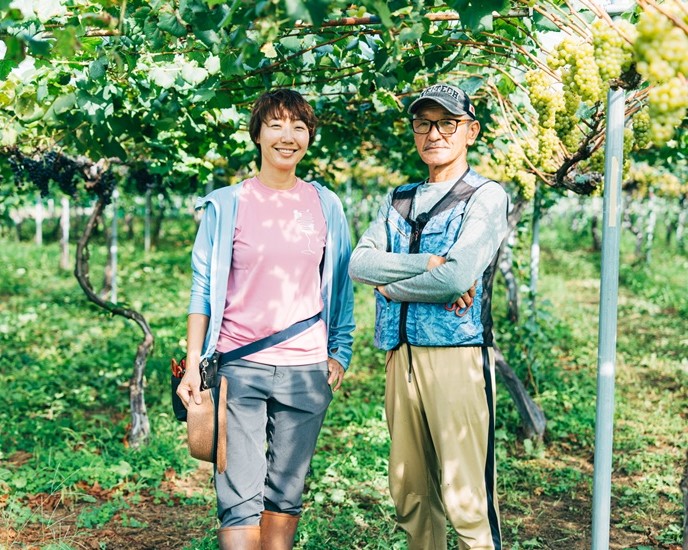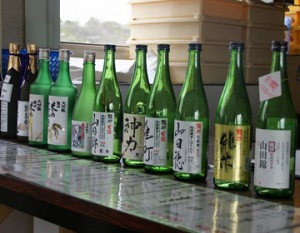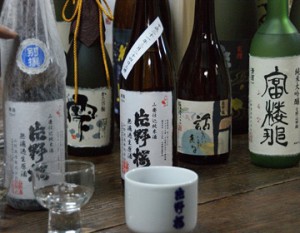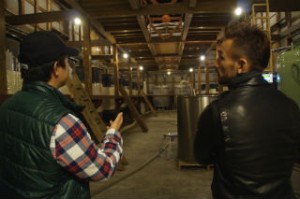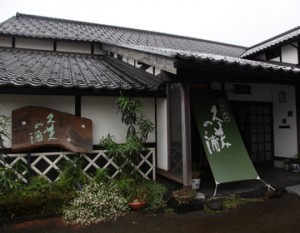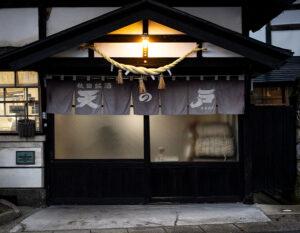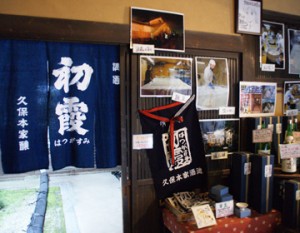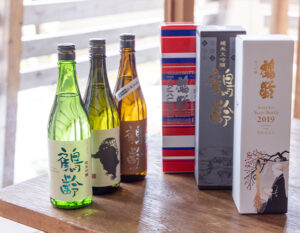Kisvin Winery, located in Shioyama, Koshu City, Yamanashi Prefecture, is an up-and-coming winery where viticulturist Yasuhiro Ogihara and young winemaker Mayu Saito began brewing in 2013. The Kisvin wines are the result of the mutual recognition of each other’s individuality and the improvement of each other’s skills by the experts in viticulture and winemaking.
With a generous love for grapes
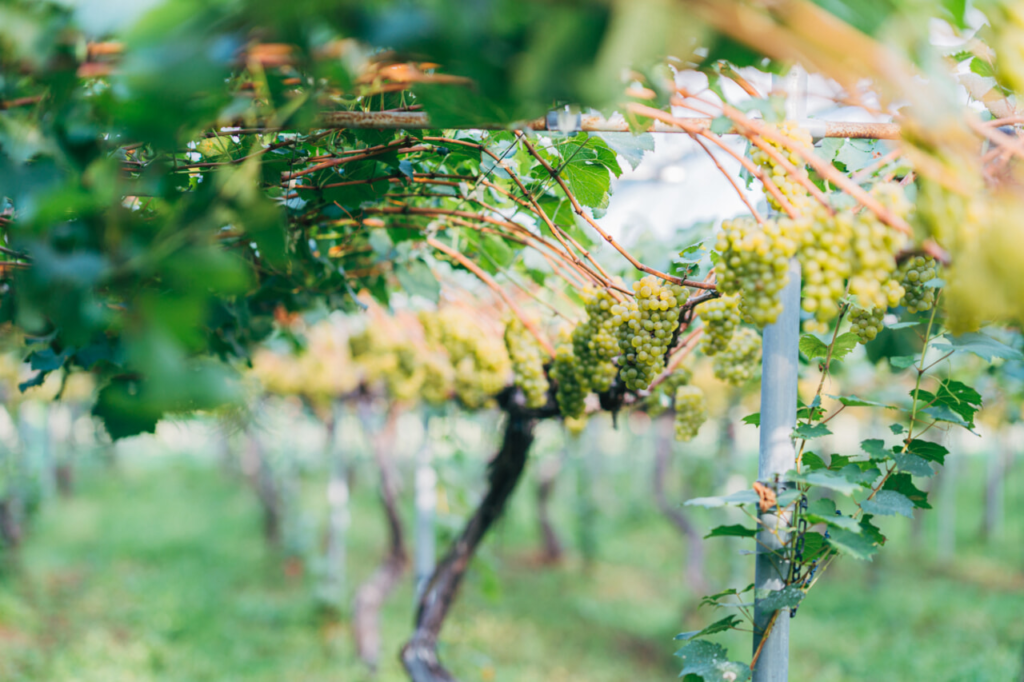
Kisvin” means ”kiss the grapes. The name “Kisvin Winery” expresses the love for grapes that makes Ogihara-san and Saito-san, who love grapes so much they want to kiss them, join forces with Saito-san, an oenologist who has studied winemaking in California and Burgundy, and Ogihara-san, who has been involved in grape cultivation for over 20 years, They believe that the quality of the grapes is directly related to the taste of the wine, and they are committed to the cultivation of high quality grapes, sparing no effort, utilizing plant physiology and the latest cultivation management techniques.
Continuously evolving with an eye on the times
Born into a family of grape farmers in Yamanashi Prefecture, Mr. Ogihara took over the family business in 2001, and in the process of converting grapes from fresh to vinification, he established “Team Kisvin,” a study group for vinification grapes in 2005, and began growing grapes for wine and expanding the scale of his business. The group sold grapes to Chateau Sakaori Winery Co. in Kofu City, which recognized the high quality of the grapes and decided to vinify them in dedicated tanks. Kisvin Koshu 2008 was then released by “Team Kisvin.
In 2009, Kisvin established an agricultural production corporation, Kisvin Corporation, which expanded the scale of its vineyards, increased grape production, and continued vinification at Chateau Sakaori Winery, while establishing its own winemaking facility and beginning winemaking in 2013.
The theory of cultivation changes with the times. If you continue with the same old methods without thinking, you are not evolving,” says Ogihara. He has arrived at his current cultivation methods through years of accumulated experience, sometimes denying what he is doing and sometimes responding flexibly to climate changes. The vineyards that Mr. Ogihara cares for are well managed from corner to corner, and the orderly arrangement of the grapes is impressive.
Thoroughly manage the fields with photosynthesis as the top priority.
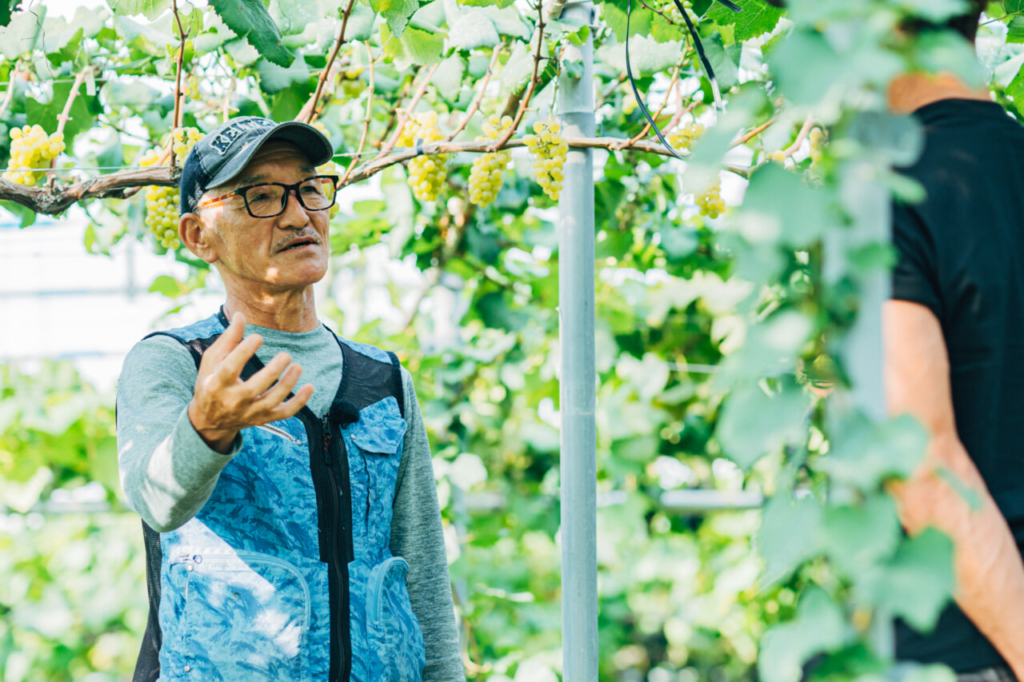
Mr. Ogiwara, who chose to grow grapes on trellises because the leaves and berries close to the ground would be exposed to morning dew and high humidity under hedge cultivation, places the utmost importance on “the health of the vines and berries. To this end, he focuses on creating an environment suitable for photosynthesis as well as protecting the vines from pests and diseases. The proper temperature for promoting photosynthesis is 20-25 degrees Celsius, and photosynthesis begins before sunrise, with the greatest increase in photosynthesis occurring around 9:00 am. Too much sunlight will cause the temperature to rise rapidly and transpiration to increase, and too much light will reduce the speed and efficiency of photosynthesis. In shelf cultivation, the upper leaves are exposed to direct sunlight, but the lower leaves and fruits are exposed to soft light suitable for photosynthesis and protected by a moderate temperature range.
Mr. Ogihara, who manages his plots under herbaceous cultivation with almost no fertilizers, wants to respect plant life, and sometimes implements innovative ideas such as grafting Chardonnay grapes onto 20-year-old Cabernet Sauvignon vines. Because of his sincere attitude toward the vines, “Pruning determines the yield and taste of the grapes in a given year, so pruning is the most interesting part. That is why pruning is the most interesting part,” he says with a smile.
Beautiful wines with pure grapes.
Mr. Ogiwara, who likes aromatic grapes, chose Koshu, Chardonnay, Pinot Noir, Syrah, and Vaonier. His ideal wine is “a beautiful wine. The ideal wine is “a beautiful wine,” one that is so clear that one can clearly imagine the grapes themselves when one takes a sip. Mr. Ogiwara wants to make wines that will be recognized around the world, which is why he believes that “it is necessary to carefully and surely do what needs to be done in the vineyards now, one by one, rather than trying new things. I haven’t yet achieved a perfect score of 100 in my mind. The challenge is how to bring it closer to 100 points,” he says, with a grim expression on his face. As a grower, I just have to make sure that the grapes are well-cultivated so that when the wine is finally made, it will not be blamed on the weather or abnormal weather conditions.
“Emerald Koshu” focusing on the color and ripeness of the fruit

Mr. Saito first encountered wine while traveling as a student, and when he experienced harvesting grapes in Corsica, France, with a wine producer who owns a vineyard and winery and handles everything from grape cultivation to vinification, aging, and bottling, he recalls, “It touched something fundamental in me. He recalls, “It touched something fundamental in me. I thought, ‘What a wonderful job it would be to grow plants, make wine from the harvested grapes, and entertain guests! He felt an intuition that “I want to make wine in Japan, where I was born and raised, that I can be proud of to the world.
Mr. Saito thought that in order to make excellent wine in Japan, it was important to study in a region that was growing by leaps and bounds, and to grasp the secrets of that growth. At the time, California wines represented a new type of winemaking known as the “New World,” and their value was rising rapidly. He went abroad to find out why this was possible, what perspectives Japan needed, and what Japan lacked.
When Mr. Ogihara happened to see a blog post about winemaking written by Mr. Saito, he went to California State University in 2009, where he was enrolled in the oenology department, and scouted out Mr. Saito. Because of his excellent grades, Mr. Saito was selected as an assistant winemaker at the university’s winery, where he also taught local students. He then went to Burgundy, France to gain more experience in brewing, and returned to Japan in 2013 when the brewery was completed in Shioyama, Koshu City, to take on the role of head brewer.
Mr. Saito, who is also involved in cultivation as a winemaker, pays particular attention to Koshu grapes. As the grapes ripen, they turn purple, and in the process, bitterness comes out. As a result, they arrived at the method of applying an umbrella to each bunch of grapes. The silver umbrella, developed by the company, blocks sunlight, allowing the Koshu grapes to ripen while still green. Mr. Saito describes Koshu grapes that have reached a high degree of ripeness but still retain a beautiful emerald green color as “emerald Koshu. He says that the grapes are thoroughly quality-conscious, which clearly shows in the beautiful color and delicate taste of the wine.
As the harvest season approaches, he carefully checks the color, acidity, and seed ripeness of the berries to determine the best time to harvest. Observing the color and condition of the seeds is especially important in order to determine the ripeness of the grapes. The vinification method is determined based on the quality of the harvested grapes: stainless steel tanks are used if the grapes are not too oaky, and barrels are used for grapes with high potential that can be aged for a longer period of time. There is no set recipe for each variety, so it is important to think carefully about what you need to do to get the best out of the grapes you harvest.

Mr. Saito is committed to “making effective use of the lees. Lees are the sediments of the wine’s components, and Mr. Saito does not remove the lees after fermentation is complete, but leaves the wine on the lees to mature. Although racking produces a clear wine, Saito does not overcook the juice, but rather skillfully uses the large amount of lees left in the wine to bring out the flavor of the lees itself. He carefully checks how much lees is used to give the wine depth, and says, “The ideal wine is one that emphasizes smoothness, but also has subtle tastes and something that makes you think a little.
To make the name of “Shioyama” famous throughout the world

The “Chardonnay Reserve,” made by carefully selecting only the highest quality fruit, is a glossy golden yellow wine with refined acidity and gorgeousness. This special brand, which Mr. Saito himself is confident that it is of the highest quality, can be enjoyed with a long aging period. Saito’s eyes sparkle as he says, “I want to make a sparkling wine that will make the name of Shioyama known all over the world,” but because of his heavy responsibilities as head winemaker, he has to be in the vineyard every day to tend to the grapes and check the wines in the winery. In order to make time for this, it is important to build a team as a winery, and as a winemaker, it is also necessary to improve my sensibility through exposure to art,” he says. While keeping abreast of the changes of the times, he also has to understand what kind of wine he likes and what the world is looking for, and “my job is to strike a balance between the two and create the ideal wine.
Passionate about winemaking and professional development

In these times of stress and hardship, just a little bit of wine can bring a moment of joy and healing. Wine is also attractive to its makers, and Saito describes it as “something that connects people to each other. I have met people I admire, it has given me business opportunities, and it has broadened my view of the world,” he said. Wine takes me to new worlds I have not seen yet.
However, he gives a grim assessment of his own winemaking, saying, “I still have a ways to go. That is why he says, “I don’t know if I will be able to do the work I want to do during my lifetime. I have to do work that I can pass on to the next generation,” he says, and strives to nurture the next generation. Mr. Saito believes that it is too late to start training apprentices after he has made it big as a brewer, and that he must grow while at the same time nurturing the next generation. I want to improve the fields and make them easier to cultivate so that I can pass them on to my successor,” he smiles.
Mr. Ogihara, nodding his head next to Saito, added, “We will set the trend and pass on our skills to the young people in this company. I am sure that in the future, new ideas and techniques will emerge that we have never thought of.
Kisvin Winery, where Ogiwara-san and Saito-san’s strong personalities and talents clash and blend to produce wines full of originality, was visited by the late Gérard Basse, a sommelier who held five Master of Wine titles and was named the best in the world, in 2017. He tasted the Kisvin Pinot Noir and praised it highly. The wines of the two winemakers will continue to surprise and inspire the world, as Mr. Basse highly praised their “unique and sensational wines made by a talented winemaker.



